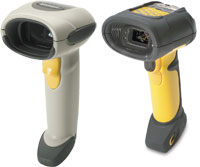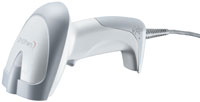Laser Scanning or Digital Imaging: Which Barcode Scanning Technology Is Right for Your Application?
 Deciding which barcode scanning technology — laser scanning or digital imaging — is right for your application can be a difficult task. The purpose of this paper is to help in your decision-making process by providing technology overviews, advantages and application uses for each of these options.
Deciding which barcode scanning technology — laser scanning or digital imaging — is right for your application can be a difficult task. The purpose of this paper is to help in your decision-making process by providing technology overviews, advantages and application uses for each of these options.
Introduction
Over the past few decades, barcode scanning has become the data capture technology of choice, enhancing processes in virtually every industry and market. Low-cost scanning solutions improve performance and reliability in a wide range of enterprise activities, and reap tremendous business benefits, including increased worker productivity, improved task efficiency, and reduced operational costs.
As scanning technology evolves and new barcode symbologies appear, industries have more choices in data capture solutions. This paper discusses two competing, and sometimes complementary, data capture devices: the laser scanner and the digital imager. We will provide an overview of the technology behind each device, list advantages for each, and discuss markets and applications in which they are used.
Datalogic Heron and Gryphon Barcode Scanners Provide Data Security in Medical Laboratories

With its five laboratories, MEDILYS provides all locations of the Asklepios clinics in Hamburg and other hospitals with a broad spectrum of medical laboratory services. Approximately 7.5 million tests in the field of clinical chemistry and approximately 220,000 bacteriological submissions are processed each year.
The Challenge
Institutions of public health are subject to strict requirements due to numerous new regulations. The new guidelines of the Federal Medical Association for the quality assurance of medical laboratorial examinations became effective on April 1, 2008. each person or institution undertaking such laboratory examinations must meet the new requirements for pre- and post-analysis in particular and introduce a quality management system.
|
The Solution
Thirty to forty Datalogic barcode readers are delivered to the MEDILYS laboratories each year. Seven complete workplaces for the analysis of samples have been installed in the laboratory of the clinic in Wandsbek alone.
The central laboratory provides various machine-readable request forms, with sample labels on which the patient and sender data are printed. Examination requirements and other information are marked in the corresponding spaces. The labels of the request form with the ordering number of the form as well as the patient data are attached to sample vessels according to the request. The correctly labeled sample is then definitively classed with the request.
The sample is registered in the laboratory by the barcode reader. The laboratory information system assigns the sample to the order from the request without a voucher. There are workplaces specially configured for the various examinations.
The sample is stored in the archive following the analysis. After the examination is completed, the sample is again scanned by the analysis device and receives an archive number. There is always recourse to the sample when it is requested or designated again.
“Rapid and flawless registration of all arriving samples cannot be achieved without the use of the Datalogic barcode readers. The reading devices support us in undergoing a large number of analyses. ” Ulrike Teege, executive assistant medical technician, MEDILYS Institute, clinical center Wandsbek, Hamburg.
Barcode labels ensure a certain identification of the sample.
Maximize the success of your restaurant with mobility

Whether your restaurant is large or small, or offers fine, casual or quickserve dining, your servers and managers will have the tools they need to capture, transmit and access information as needed, wherever they happen to be. As a result, overall operational efficiency is maximized. Productivity is improved through process automation, improving staff utilization. Servers and managers are more effective, able to take the right action at the right time to deliver a level of service that will not only set you apart from your competition — but will keep your guests coming back. And the ability to increase sales and the number of guests while substantially improving service enables restaurants all over the world to achieve a new level of success…and profitability.
Download whitepaper: Maximize the success of your restaurant with mobility
How Mobile Printers Drive Efficiency Throughout the Supply Chain
Today’s Reality—Closing the Productivity Gap
With an increasing emphasis on cost reduction, global enterprises are looking for ways to improve efficiency and accuracy in their supply and distribution chains. To remain competitive, distribution centers, manufacturers, and short-haul and long-haul carriers must change the way they label and track goods. Success depends on maximizing efficiency throughout all supply chain operations—front to back. Exploiting mobile labeling technology is fundamental to achieving optimal efficiency.
The most effective way to improve efficiency and keep labor costs under control is to minimize the amount of time required to label materials, work in process, finished products, boxes, and pallets. Centralized labeling solutions significantly reduces productivity and injects inaccuracies; thus, even the slightest improvement to the handling process will yield significant cost savings.
Barcode and RFID labels are by far the fastest and most accurate method to identify and track materials and products throughout the supply chain, and within warehouses and distribution centers. Used in multiple industries, centralized printing stations affix barcodes and RFID to the materials, finished goods, and packages. When integrated with enterprise resource planning (ERP) software, these systems are a proven solution for significantly boosting operational efficiencies and reducing costs. However, tightening the supply chain even further calls for mobile printing solutions that equip workers with seamless mobility throughout the warehouse—wherever and whenever they need it.
“By using mobile wireless printers at the receiving dock to issue goods receipts, Driscoll Strawberry Associates reduced the time to process receiving transactions by 25 percent.1”
1. Zebra Case Study, “Driscoll Picks Perfect Mobile Solution for Distribution Account Reconciliation”




